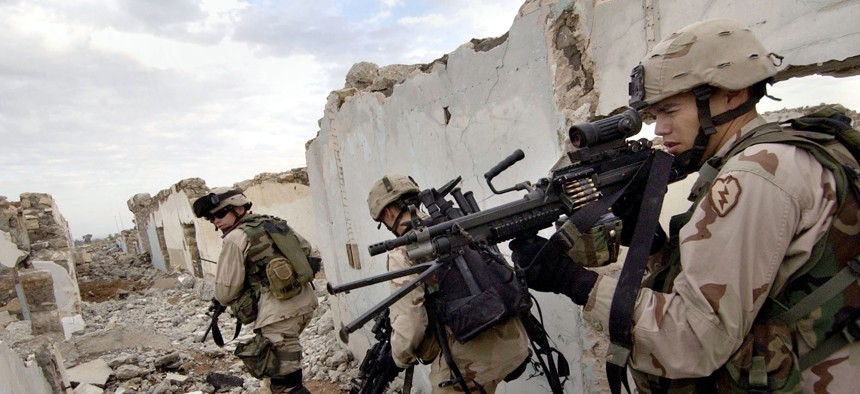
U.S. Army soldiers search for insurgents suspected of planting a roadside bomb in Mosul, Iraq Sunday, Nov. 21, 2004. AP Photo/Jim MacMillan
'Esper's Lie?' I Don't Think So
After nearly a generation of dominating focus on counterinsurgency operations, the U.S. military is underprepared in 2020 for great power competition.
A recent Defense One commentary titled “Esper’s Convenient Lie” contains a number of statements challenging how the defense secretary is portraying the Pentagon’s focus on counterterrorism wars of the past and the current shift to state-on-state conflict with China which warrant our attention — but let’s start with the title.
A lie is an intentionally false statement. Even by the standards of today’s hyper-partisan rhetoric, it is a serious charge to claim Defense Secretary Mark Esper is lying regarding the degree to which he believes the Afghanistan and Middle East wars of the 2001-2020 era derailed the modernization of conventional military weapons needed to counter China today.
Paul Scharre’s serious charge is that Esper’s claim that “two decades of countering violent extremism left the U.S. under-prepared for a near-peer fight doesn’t hold water,” and that in fact the “Defense Department has spent billions on modernization programs aimed at nation-state threats.”
The U.S. military inarguably received additional billions during those years, but those resources were directly focused on the fights overseas. Additionally, and possibly more importantly, the military’s intellectual focus, training, and organizations were diverted to succeeding in the pressing counterinsurgency fights of the day. After nearly a generation of dominating focus on counterinsurgency operations, that the U.S. military should find itself underprepared in 2020 for great power competition should be no surprise to anyone and is intuitively true for those who lived it.
In the Army, from 2002 to 2013, nearly all equipping programs came to be focused on the fights in Iraq and Afghanistan. Across-the-board equipment shortages (we called them holes in the yard) that existed at the start of those conflicts in radios, night vision gear, small arms, drones, electronic warfare systems to combat IEDs, armored vehicles, and other commodities meant every dollar provided by Congress had to be spent trying to fill shortages on the battlefield, not preparing for some future nation-state fight. The Marine Corps went through a similar experience.
Army leaders prioritizing those overseas fights admittedly did not sufficiently focus on narrowing the scope and concept of the Future Combat System, the Army’s sole remaining modernization program that focused on the future. As a result, FCS became overly ambitious and costly. That however does not deny the fact that the Army once again today is seeking a system of networked capabilities eerily similar to the promise of FCS in order to better counter Russia and China.
In April 2009, when Defense Secretary Robert Gates cancelled FCS he cited the need to “enhance the capabilities to fight the wars we are in today and the scenarios we are most likely to face in the years ahead.” He was telegraphing to the services to focus on counterterrorism and counterinsurgency more than nation-state conflict. And for the most part, the services either complied or had their programs terminated. Systems like the SLAMRAAM, a ground-based anti-aircraft system, was cancelled in 2011 because at the time it was inconceivable that U.S. forces would ever have to content with a hostile air threat. In their place, capabilities designed for low-threat counterinsurgency operations like the Grey Eagle drone were initiated. What a difference nine years makes. Fielding an air defense capability is once again one of the Army’s highest priorities and the services are cutting back buys on drones.
Scharre glosses over Gates’ curtailment of the F-22 Raptor as a “rare” example of capabilities being cancelled that are necessary for great power competition. Instead it is the prime example, the F-22’s cancellation was truly emblematic of this period where any system that could not demonstrate direct utility in counterinsurgency conflict was judged irrelevant. In 2008, Gates said, “The reality is we are fighting two wars, in Iraq and Afghanistan, and the F-22 has not performed a single mission in either theater.”
So was the Pentagon, as Scharre claims, continuously focused throughout this period on nation state conflict? Perhaps we should ask former Air Force Secretary Michael Wynne, or former Air Force Chief of Staff Gen. Michael Mosely who were fired, in part, for the offense of continuing to advocate for the F-22 in the face of Gates’ ill-considered curtailment decision.
Gates is famously remembered for his quote that the Pentagon has an abysmal record of predicting where future combat will take place, saying “We have never gotten it right.” When Russia invaded the Ukraine in 2014 and China showed their true colors fortifying reefs in the South China Sea, Gates was proven both right and wrong. He was right that the Pentagon can’t accurately forecast the future, but he was wrong that the U.S. military had the luxury to prepare only for counterinsurgency operations in the future. Unfortunately, by then the systems needed to counter nation-state adversaries had been consigned to the scrap heap and the money diverted to other less-capable systems needed in Iraq and Afghanistan.
Critics and scholars can and should debate whether the Pentagon’s decision to totally shift its emphasis to the wars in Iraq and Afghanistan was appropriate. The nation had troops in harm’s way and arguably no effort should have been spared to ensure they had the best. Russia appeared benign to most and China’s true nature had not yet been revealed.
What is not in doubt is that the money, time, and attention spent on those wars resulted in a missed generation of modernization and a military that is less than prepared for competition with China and Russia.
A lie? I don’t think so.
Thomas Spoehr is director of the Heritage Foundation’s Center for National Defense. Prior to joining Heritage, Spoehr served for over 36 years in the U.S. Army, attaining the rank of Lieutenant General.



